Most people use Wifi to connect to the Internet nowadays. With the release of Windows 11, some users complained that their Wifi keeps disconnecting randomly. As we go through the Microsoft forums, we came to know that this wifi disconnect problem has been there since Windows 10.
Many users have reported facing a Wi-Fi connectivity issue after upgrading to Windows 11. This article gives you all the possible ways you can fix the problem and not regret shifting to the new OS.
Table of Contents
It may be possible that your Wi-Fi adapter keeps reconnecting to the router every 10-15 mins. Some users have reported that their network adapter is not recognizing any wireless SSIDs nearby, or not being able to connect to one even after entering the correct credentials.
There can be a bunch of reasons why your Wi-Fi is acting out after an upgrade. Let us continue to see how we can resolve this issue.
Fix Wi-Fi Disconnection Issue in Windows 11
Restart Wi-Fi network adapter
The network adapters also maintain their cache, which can result in any old data which is stored not being updated, hence the Wi-Fi keeps from connecting to an SSID. We can try and resolve the issue by restarting the Wi-Fi network adapter.
- Open the Network Connections page in the Control Panel by typing in ncpa.cpl in Run.
- Right-click on the Wi-Fi network adapter and click Disable from the context menu.

- Now right-click on the Wi-Fi network adapter again and click Enable.

The network adapter has now been restarted, without rebooting the computer. Check to see if the issue has been resolved. If not, continue to perform the mitigation methods below from a less aggressive approach towards a more aggressive approach.
Enable Connect Automatically
The next thing you want to do is make sure the Connect Automatically is enabled for the SSID when in range of your Wi-Fi adapter since that might be the reason why your Wi-Fi keeps disconnecting. Here is how to do so:
- Connect to the Wi-Fi that you are facing an issue with.
- Now navigate to the following:
Settings app >> Network & internet >> Wi-Fi - Now click on the Properties option (SSID Properties).
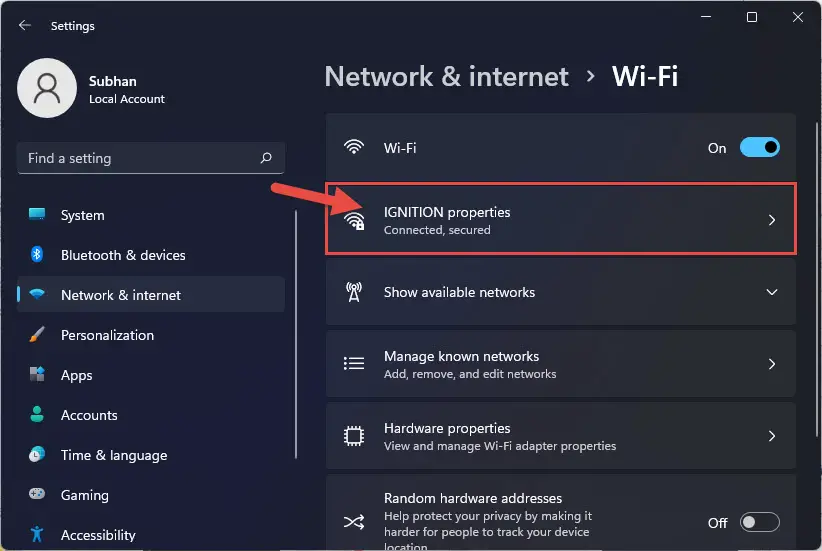
- On the Properties page, make sure the box next to “Connect automatically when in range” is checked.
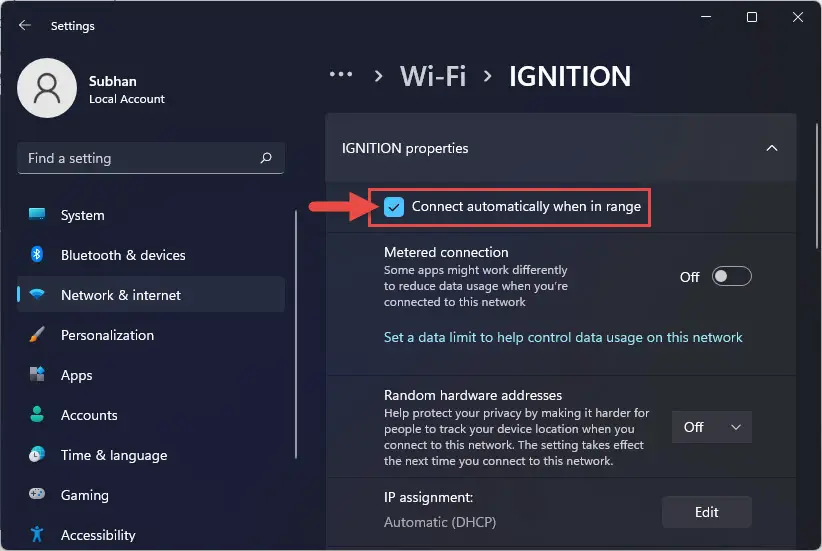
Run the network troubleshooter
Windows 11 comes with a nifty utility to troubleshoot its different features and components. It can also be used to troubleshoot any problems automatically with your Wi-Fi.
To run the troubleshooter, navigate to the following:<br>Settings app >> System >> Troubleshoot >> Other troubleshooters- Now click Run in front of Network Adapters.

- From the Network Adapter Troubleshooter window, select Wi-Fi and then click Next.

- The Troubleshooter will scan for problems with the Wi-Fi network adapter. If any are found, it will suggest the necessary action(s) to take. Will do the needful.
This should fix any known misconfigurations with the Wi-Fi adapter. If you do not find any ambiguity with it, move on to the next step.
Run Dependency Services
The visibility of Wi-Fi networks in the vicinity depends upon several services in which the operating system is running. We need to ensure that they are up and running on your device so that the network adapter can operate as it is supposed to.
- Open the Services Management Console by typing in services.msc in Run.
- Now double-click Network Location Awareness and set the Startup type as Automatic from the drop-down menu. Click Apply and Ok when done.

- Now set the Startup type for the following services as mentioned below by repeating step 2:
- Network List Service –> Manual
- Network Event Log –> Automatic
- Windows Update –> Manual
Once done, check to see if the issue has been resolved.
Uninstall Outdated VPNs
This step is only for those who have any old and outdated VPNs configured on their machines, as it might be a reason why the Wi-Fi won’t display any available networks.
First, you need to check if you have any such VPN configurations.
Note: We suggest you create a system restore point before proceeding forward as this method involves editing of Windows Registry, which can corrupt your OS if not done correctly.
- Open Command Prompt with administrative privileges by typing in cmd in Run.
- Now enter the following command:
netcfg -s n
This command will list all the network adapters, network protocols, and services currently running on your computer.
- Check to see if the list includes DNI_DNE entry. If it does, it means you have an outdated VPN on your computer which needs to be removed.
- If you do find the entry in step 3, run the following command to remove the VPN’s registries.
reg delete HKCR\CLSID{988248f3-a1ad-49bf-9170-676cbbc36ba3} /va /f - Now enter this command:
netcfg -v -u dni_dne - Once done, restart the computer.
If the problem was caused by VPN software, you should now be able to see and connect to any Wi-Fi network within your vicinity.
Install Pending Windows Updates
Often outstanding Windows updates can cause the Wi-Fi adapter to behave abnormally. Therefore, we suggest that you check whether there are any pending updates or not. If there are, install them.
To check for Windows updates, do the following:
- Navigate to:
Settings app >> Windows Update - Click Check for updates.
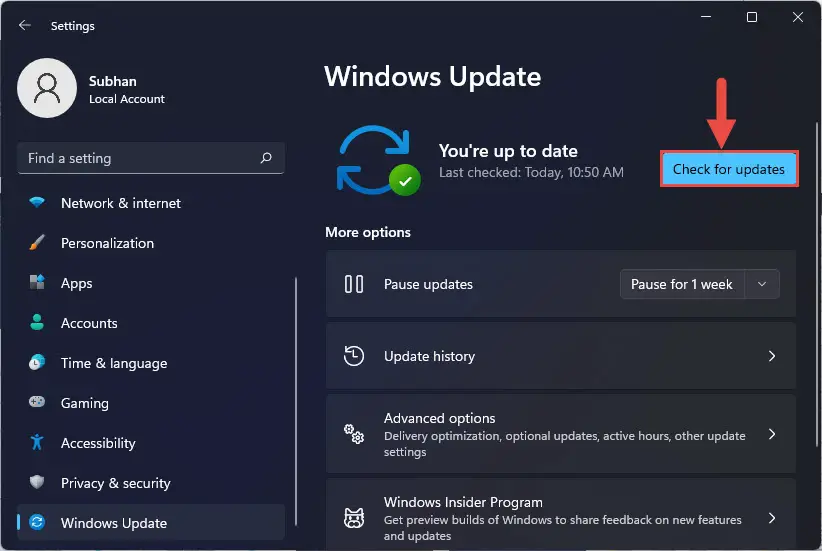
- The system will now scan for any pending updates. If found, click Download Now (if they do not start downloading automatically).
- Once downloaded, click Install Now (if the updates do not start to install automatically).
- Once installed, reboot the computer.
When you return, check if the problem still persists.
Reset Network Using Settings App
You should also try to reset your network adapter. Microsoft has provided a button in the Settings app that will reset all network adapters and their configurations for you.
- To reset your network using the Settings app, navigate to:
Settings app >> Network & internet >> Advanced network settings >> Network reset - Click Reset Now.
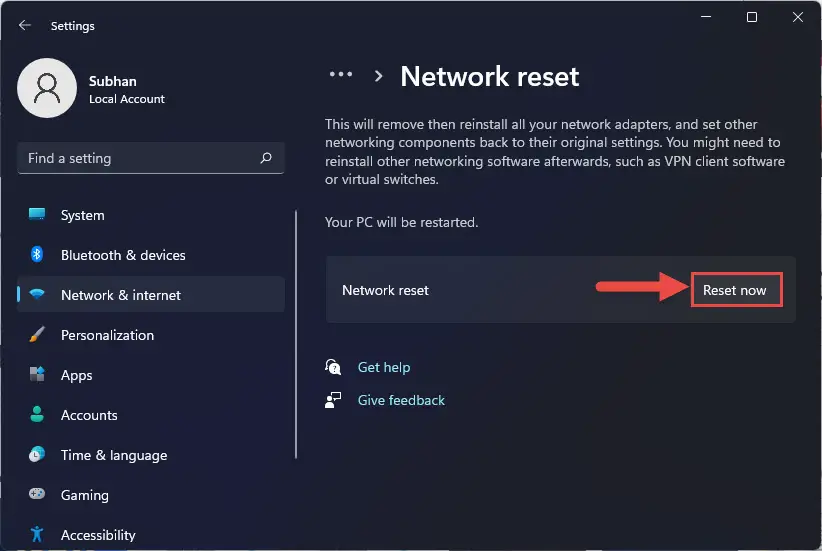
- In the confirmation dialog box, click Yes.
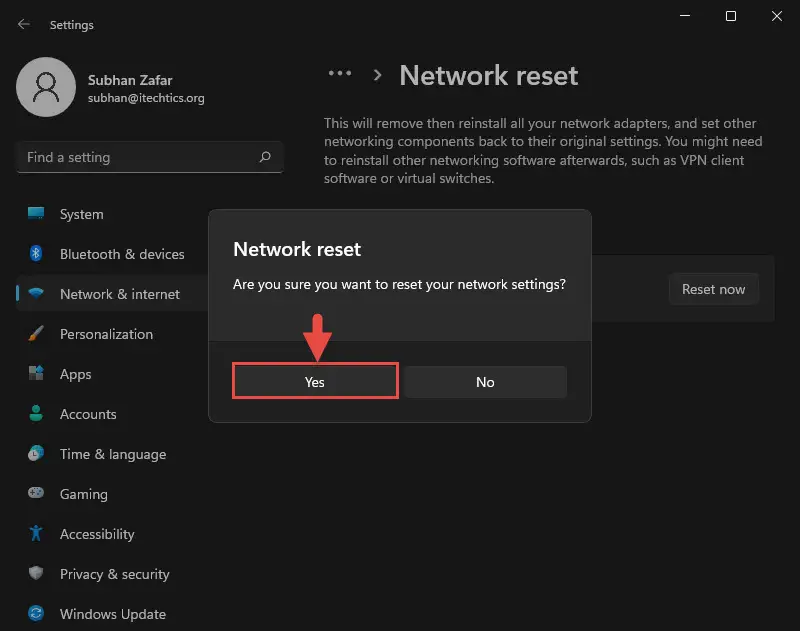
- You will now be prompted for a completely automatic shutdown. Click Close and then restart your device.

If this does not resolve your issue, you can also try resetting the TCP/IP stack from the guide below.
Reset TCP/IP Stack
The netsh command can be used to view or configure the network settings in a Windows environment by providing the right parameters.
Note: This process will erase all current configurations of all the networking ports and adapters on your device, which also includes all inactive ones, as well as the virtual network adapters. Hence, they will need to be reconfigured once the process is complete.
- Open Command Prompt with administrative privileges.
- Type ipconfig /release to remove current IP settings.

- Type ipconfig /flushdns to remove DNS cache.

- Type netsh winsock reset to reset Windows Sockets API cache.
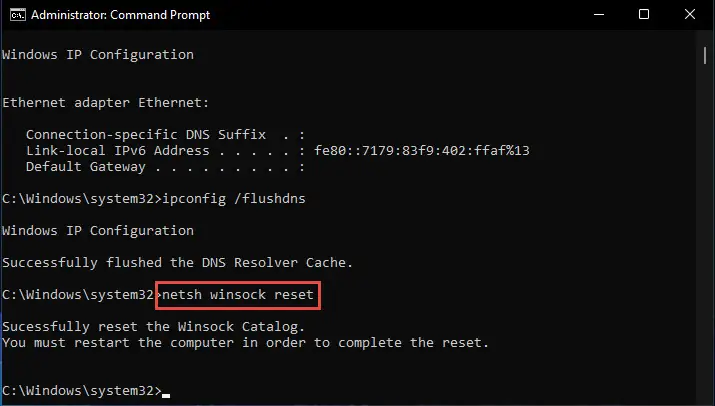
- Type netsh int ip reset to reset TCP/IP stack cache. Do not restart the computer just yet.

- Type ipconfig /renew to request new IP settings from the server.

- Restart the computer.
If you want to automate the process, simply copy-paste the above-mentioned command in a text document, and save it with any name of your choice ending with .bat file extension. This will create a batch file, which will execute all commands inside when you double-click it.
If your device’s Wi-Fi is still disconnecting frequently or is not displaying on any nearby networks, continue to perform the techniques discussed below.
Update Wi-Fi Adapter Driver
Drivers are what run the hardware through the operating system and let the two communicate with one another. There is a chance that the Wi-Fi driver may have been corrupted, or is simply not compatible with the update that you have recently installed on your Windows 11.
First, you need to check what adapter your computer is hosting to download the right driver.
- Open the Device Management console by typing in devmgmt.msc in Run.
- Now expand Network Adapters and look for the device name.

- Now navigate to the manufacturer’s website using a web browser, look for a matching network adapter, and download its latest available driver.
- Once downloaded, return to the Device Manager and right-click the network adapter, then click Update driver from the context menu.
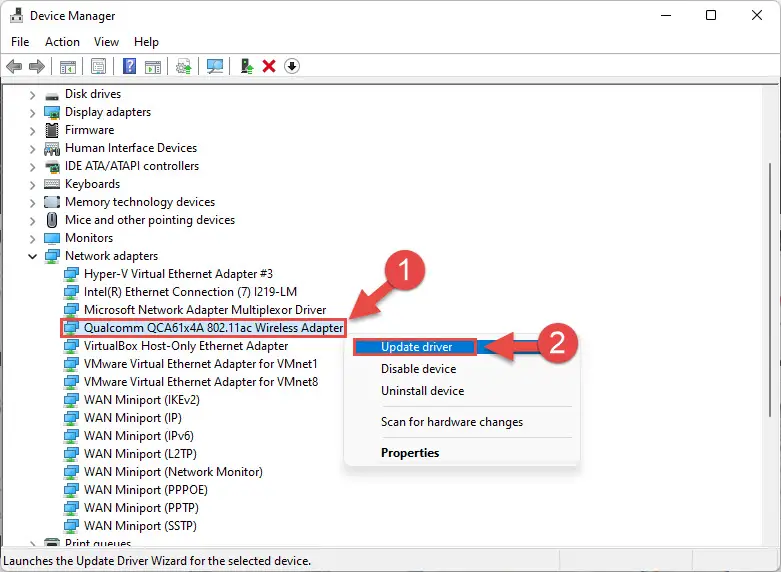
- In the Update driver window, click Browse My Computer for drivers and then navigate to the downloaded driver.

- Once the new driver is installed, restart the computer.
Now check if the disconnection issue persists. If it does, we still have a few tricks up our sleeve to mitigate it.
Change Power Mode to Maximum Performance
By default, the power mode for the network adapters is set to “Medium Power Saving” in the case of a laptop in Windows 11. This needs to be changed to Maximum Performance to rule out the cause of disconnection being a power concern. Here is how to do it:
- Open the Power Option in the Control Panel by typing in powercfg.cpl in Run.
- Click Change plan settings in front of the Selected plan.

- On the next page, click Change advanced power settings.
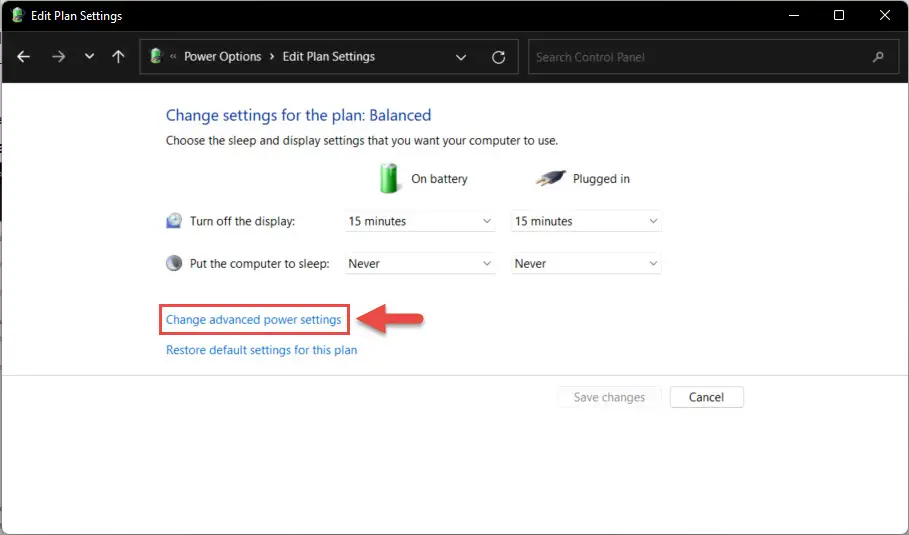
- Now expand Wireless Adapter Settings and then Power Saving Mode from the “Power Options” window.
- Now select Maximum Performance from the drop-down menu in front of On battery and Plugged in, and then click Apply and Ok.
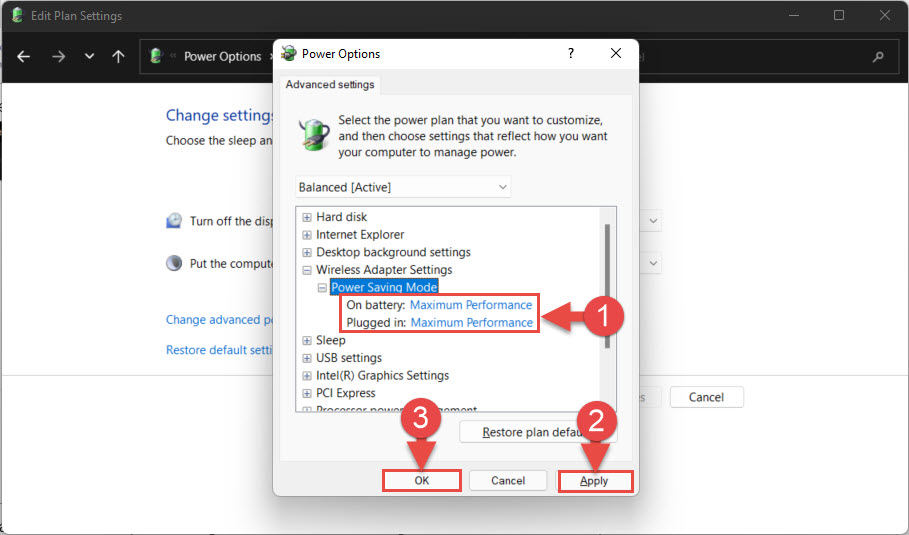
Disallow Computer to Turn Off Wireless Adapter
If you notice that you face a disconnectivity issue when the computer is powered on or wakes up from Sleep mode, you should perform the following to disallow your device from switching off the wireless adapter.
- Open the Network Connections page in the Control Panel by typing in ncpa.cpl in Run.
- Right-click on the Wi-Fi network adapter and click Properties from the context menu.
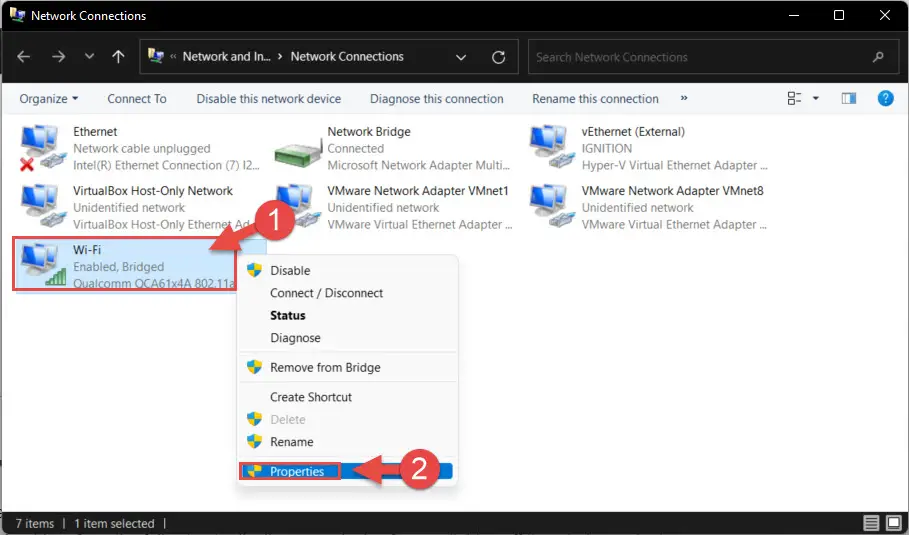
- Click Configure in the Wi-Fi Properties window.

- In the next window, switch to the Power Management tab. From there, uncheck the box next to “Allow the computer to turn off this device to save power,” and then click OK.

- Restart the computer.
Once the PC reboots, check if the issue has been resolved.
Set Network Profile to Private (Using PowerShell)
Windows gives users the option to select a network type when a new network is connected to the computer. Windows will set Windows Firewall rules according to the network type selected, which means stricter rules can impact your Wi-Fi’s connectivity and reliability. Therefore, try setting your network profile to “Private” for the most lenient firewall policies.
- Launch Windows PowerShell with administrative rights.
- Now paste the following command to obtain the details of the Wi-Fi adapter, the connected SSID and the current profile.
Get-NetConnectionProfile
- Note the “NetworkCategory” of your Wi-Fi adapter. If it is anything but Private, then it needs to be changed. Use the following command while replacing SSIDName with the name of the network it is connected to to change its profile to Private:
Set-NetConnectionProfile -Name "<em>SSIDName</em>" -NetworkCategory Private
- Now confirm that the profile has been changed running the command in step 2 again:
Get-NetConnectionProfile
- Restart the computer.
Once the device reboots, check to see if the problem has been resolved.
FAQs
Why does my PC Wifi keep disconnecting?
The most common reason for Wifi disconnection is an outdated wireless driver. You can update this driver by downloading the latest one from the manufacturer’s website.
How do I fix Wifi disconnection?
It is not necessary that the fault is in your computer. Try restarting your router as well as your computer for basic troubleshooting before resetting the wireless adapter entirely.
How do I change Wifi settings in Windows 11?
You can change your Wifi settings by opening the Settings app, then go to Network & internet >> Wi-Fi, and manage your settings.

1 comment
Neil young
Worked perfectly. Thanks a lot ☺️.